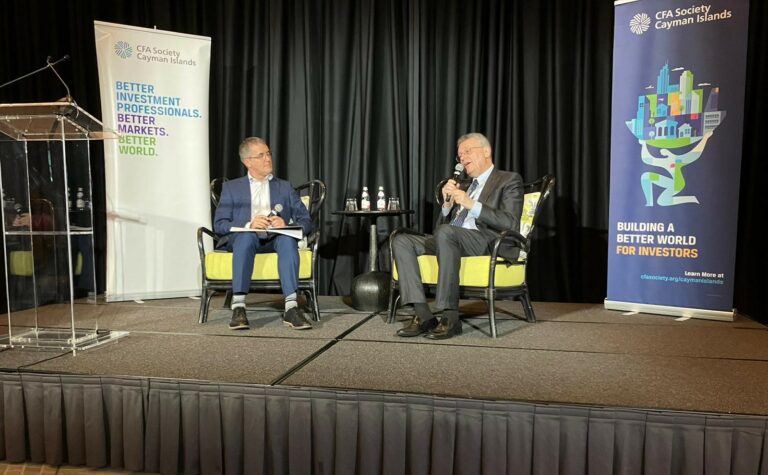
The CFA Society’s Cayman Investment Forum on 2 Nov highlighted threats and opportunities for investors from an environment that is largely shaped by technological breakthroughs and unforeseen geopolitical events.
The economic and investment environment is unpredictable and more volatile than it has been in a long time. Armed conflicts, rapidly rising interest rates, high inflation and changing supply chains are complicating investment strategies.
Technological breakthroughs in artificial intelligence, meanwhile, threaten to disrupt manufacturing and business processes, and disintermediate entire professions.
For Victor Shvets, global strategist at Macquarie Bank and author of the 2020 book ‘The Great Rupture’, the current economic situation is unlike anything experienced in the past 100 years.
Shvets told delegates at the CFA Society’s 9th Annual Cayman Investment Forum, the closest comparison to today’s situation may be the 1930s.
Shvets argued that since the 1990s the macro trends of globalisation, digitalisation and financialisaton generated a wave of disinflation, and more recently declining interest rates, lower cost of capital and comparatively low volatility.
Geopolitically this period benefited from a peace dividend. Although economic growth was characterised by secular stagnation, investment choices were predictable, he said, because there was a trendline one could trade against. The 1970s and 1980s were the opposite with inflationary pressures dominating but equally reliable data points to help guide investment strategies.
“Now, to me, going forward over the next 10 years, and certainly over the next couple of years, the environment will be very, very different. Why is that? Because we have both disinflation and inflation at the same time. So, we have no trendline.”
In his book Shvets describes how humanity encountered three major turning points over the last 1,000 years that created an environment to either enhance or erode the ability to grow and prosper. Now, he posits, the world is on the cusp of another such juncture.
The merger of disruptive information technology and deep financialisation, which Shvets likens to the Fujiwara effect of two hurricanes merging and reinforcing each other, only accelerates the pace at which this threshold will be reached.
Disinflation
The highly disruptive information age is behind much of the disinflation experienced over the last 25 to 30 years and is likely to strengthen, according to Shvets.
“Think of ChatGPT, its inbuilt evolution will create a Death Valley for most white collar employees over the next five, six, seven years. They will experience what factory workers in Detroit, Michigan and Melbourne and Birmingham, and Manchester experienced in 1990s,” he said. “And remember, ChatGPT is just an outgrowth of artificial intelligence. Artificial Intelligence is general purpose technology, which means it permeates everything.”
Robotics, automation, 3D printing, quantum computing and other technological breakthroughs will disintermediate a wider section of the labour force and reduce marginal costs.
Shvets believes eventually factories will disappear and supply and value chains atrophy, extending the disintermediation to blue collar workers.
“It’s going to take at least 10 to 20 years to propagate through the system. But it will.” And by that time, he said, “I don’t think there will be anything left that actually humans can do or can contribute to.”
This process, Shvets said, is reinforced by financialisaton, as well as higher debt levels and leverage. In the 1950s, 60s and 70s economies needed about $1 to $1.50 of liquidity and debt for every dollar of GDP generated. “Today we need about $3 to $4,” he said, adding that the financial economy had become the tail wagging the dog, i.e. the real economy.
However, it was too late to reverse debt levels and inflated asset prices as this would reduce prosperity. “That train has left the station.”
Inflation
Shvets described a world that going forward will still have a strong disinflationary backdrop and secular stagnation, but increasingly high unexpected volatility.
Inflationary pressures, he argued, will come from proliferating “black swans”, disruptive events that come as a surprise and have a major effect, and “fat tails”, a higher probability of extreme outcomes.
Originally considered to be once-in-a-generation events, black swans have become increasingly frequent, such as the COVID pandemic or Russia’s invasion of Ukraine. And the likelihood of extreme effects from climate change, social polarisation within countries or geopolitical tension between countries is increasing.
As a result, defence spending is likely to rise globally, as is the cost of addressing climate change. Interest rates on the other hand are going to experience much more extreme swings.
Citing investor Warren Buffett, Shvets said “neutral interest rates are our response through fiscal, monetary, political and military means to the black swans we’re facing.”
The neutral interest rate – the rate that balances aggregate demand with aggregate supply and generates stable inflation – had been on a downward trend for about four decades.
Yet, it took only 18 months to bring it back up, he noted. “So, what you’re going to see is much more unstable neutral rates. In other words, a neutral rate of zero is just as likely as three, and one is just as likely as four.”
Implications for investors
A high volatility of neutral rates, policy rates and risk-free rates would make it very difficult to predict business and economic cycles, which will disappear, he suggested.
That means investors have to be short term without any preconceived ideas reacting to market signals, which usually requires an enormous investment in technology.
Or, alternatively, they must do the exact opposite by having very strong views and convictions, because at a time when no one knows what is going on, having clarity has a value that will get paid for executing a particular strategy, he said.
“The problem is for about 90% of investors that it doesn’t describe what they do, because they are somewhere in between.”
Shvets recommended rather than aiming for conventional diversification, investors should build resilience into their portfolio by looking for strong circular productivity drivers.
This would include any company that is growing productivity faster than the frontier in its industry, whether it be in robotics, automation, biotech, alternative energy or transport. Commodities and capital goods companies are another area because of the need to upgrade infrastructure.
Relative to the size of the economy, US companies invest about the same amount today they did in the 1970s. But while back then they invested mostly in machinery, equipment, roads and buildings, today’s investments in robotics, automation and software have grown their share.
One thing that should not have a place in resilient portfolios, he advised, is cyclical and value investing, which should only be used occasionally on an opportunistic trading basis.
US corporates, he believes, will adjust to the new economic landscape, just as they did in the 1970s, but the current environment will in his view last at least a couple of decades.


